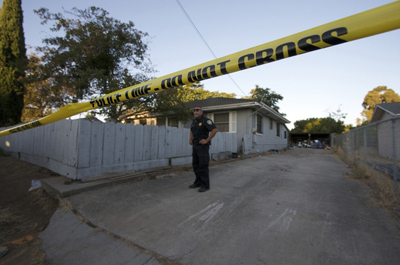
(Kevin Bartram/Reuters)
Five cities - Long Beach, Los Angeles, Newark, Oakland and Oklahoma City - are the U.S. capitals of gang homicide. That's according to a new report from the Centers for Disease Control and Prevention, which also found that homicides in each of those cities have their own local flavor.
The report is based on data from the CDC's National Violent Death Reporting System, comparing gang and non-gang data on violence and homicide. Analyzing data from between 2003 and 2008, the report looked at large cities in 17 states.
Drive-by shootings, for example, were more likely to occur in gang-related homicides than other types of homicide in Los Angeles and Oklahoma City. Drive-bys accounted for 24 percent of all gang-related homicides in those two cities.
While gangs are often thought to be associated with the drug trade, homicides that were both drug and gang-related were far less common than those that involved drugs alone. These figures also vary dramatically from city to city. In L.A. and Long Beach, fewer than 5 percent of all homicides were associated with known drug trade or use. In Oakland, that figure was 12.5 percent among gang-related killings, compared to 16.5 percent of non-gang homicides. In Oklahoma City, drug-related homicides made up 25.4 percent of gang-related homicides, slightly more than the 22.8 percent share of non-gang homicides. Of the top five gang homicide cities, Newark was the only city with a significantly higher proportion of drug-related gang homicides compared to non-gang homicides.
And the victims also differ between cities. In Los Angeles and Oakland, most gang victims of homicide are Hispanic. In Oklahoma City, they're mostly black - and at a significantly higher rate than non-gang homicides. This ethnic dominance seems to make sense in L.A. and Long Beach, where Hispanics make up 48 percent and 40 percent of the population, respectively. But in Oklahoma City, blacks only account for about 15 percent of the population.
In Los Angeles and Long Beach, gang homicides account for the majority of homicides among 15 to 24-year-olds, 61 and 69 percent, respectively. In both the gang and non-gang worlds, homicide is the second leading cause of death among people aged 15 to 24.
Overall, gang members in L.A., Long Beach, and Oakland tended not to mix business with homicide. Very few gang homicides in these cities were also associated with crimes of other sorts, with just 0 to 3 percent being connected with other crimes. This is far less than the 9 to 15 percent range in non-gang homicides in these cities.
While gang-related homicides across cities tend to be quite different, there are some shared characteristics between them. In general, they tend to involve firearms, occur in public, have predominantly male victims aged 15-19, and are based on retaliation.
The CDC cautions, however, that complete statistics on gang-related violence and homicide is difficult to track. Few states accurately report gang-related crime statistics well, and those that do are often limited by the information available at the crime scene. Tackling gang crime is clearly a challenge in many cities. How those crimes differ from place to place is an indication of the complexity facing law enforcement. But understanding the regional and even inter-regional differences in gang crime can help to address it and reduce the number of victims.











